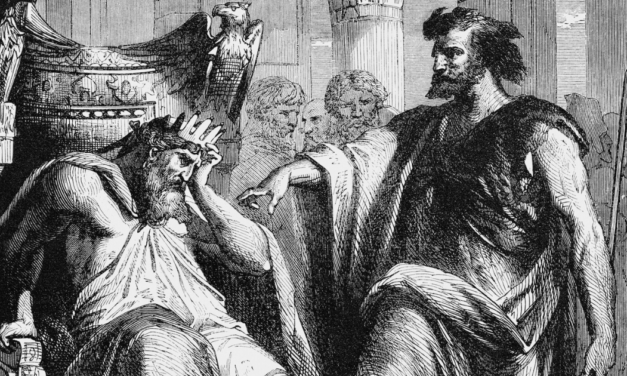This review first appeared in the Christian Research Journal, volume 20, number 03 (1998). For further information or to subscribe to the Christian Research Journal go to: http://www.equip.org/christian-research-journal/
Jesus, Peter and the Keys (JPK) addresses what became, during the Reformation, a major issue — papal infallibility and its consequences. The authors are Catholic laymen, two of whom have roots in evangelicalism. They try to make their case for papal authority from the Scriptures and church tradition. JPK is endorsed by a number of Protestants and former Protestants (and one Orthodox priest). Prominent Roman Catholics such as Dr. Scott Hahn and Fr. Mitchell Pacwa recommend the book as well.
Part One attempts to make the claim of Petrine supremacy over the church. In Chapter One, Peter’s position among the disciples is examined. Catholic scholar Michael Winter states that in the Gospels and the Book of Acts Peter is mentioned more than the rest of the Apostles combined (pp. 3–4). What is not said is that after Acts 12 the focus changes from Peter to the apostle Paul.
The episode in Mark 9:2–5 where Peter takes the initiative in proposing to the transfigured Jesus that tents be erected for Jesus, Elijah, and Moses is cited as proof of his primacy among the apostles (5). The context of this incident, however, leads only to the conclusion that Peter was speaking out of turn and was at best frightened and at worst confused about the sequence of events leading to the cross and the ultimate glorification of Jesus.
The book then addresses what is central to the Catholic-Protestant debate over the status of Peter, namely, the identity of “this rock” in Christ’s statement in Matthew 16:13–20. Historically, scholars have offered the following interpretations: (1) “This Rock” refers to Jesus Himself; (2) “This rock” is Peter’s confession of Jesus; and (3) “This rock” refers to Peter’s person. Church history reveals that these three understandings of the “rock” passage were held by a number of early church fathers both in the East and the West. Indeed, some can be quoted as holding more than one view (e.g., Augustine).1
The Roman Catholic doctrine of papal infallibility begins with the view that Jesus was referring to Peter in a singular way and designating him as the supreme earthly ruler over the church. Further, his authority was transferred to his successors as the bishops of Rome.
The authors marshal a number of prominent Protestant scholars who hold the “rock = Peter” view. For example, New Testament scholar D. A. Carson (18) is quoted, “If it were not for Protestant reactions against extremes of Roman Catholic interpretations, it is doubtful whether many would have taken ‘rock’ to be anything or anyone other than Peter.”2
Yet, Carson in the same context states, “None of this requires that conservative Roman Catholic views be endorsed.” Indeed, “The text says nothing about Peter’s successors, infallibility, or exclusive authority.”3 Therefore, as Norman L. Geisler and I say in our book, “even if Peter is the rock referred to by Christ, as some Protestant scholars believe, he was not the only rock in the foundation of the church, as many early church fathers point out.”4
The authors of JPK cite Robert Sungenis some 25 times as an expert in Greek grammar. Mr. Sungenis, a convert to Roman Catholicism, possesses a Masters degree from Westminster Seminary and has participated in a number of debates involving Catholic/Protestant doctrinal differences. In a personal letter to the authors (25), he appears to respond to a point we made in our book concerning the rock equaling Peter.5 I say “appears” because Sungenis does not directly quote from, or identify, our work. Further, he confuses the late John Gerstner with my coauthor, Norman Geisler. Sungenis claims that we err when we say that “whenever Peter is referred to in this passage it is in the second person (‘you’) but ‘this rock’ is in the third person.”6
We derived this argument from James White’s book, Answers to Catholic Claims, where he states, “Note that when Christ speaks to Peter He does so in the second person, that is, direct address.” However, “the term ‘this rock’ is third person making the differentiation between ‘Peter’ and ‘this rock’ complete….He is speaking to Peter about the ‘rock.’ Hence, the text differentiates between Peter and the rock in two ways: the form of the word, and the person of address” (emphasis in original).7 White’s argument is that Jesus is shifting in his terminology by referring to something other than Peter. His use of second or third person is defined by “direct address” and “indirect address.”8
In Chapter Two, the authors state that the power of the Keys (Matt. 16:19) apply to Peter alone. In 1 Peter 2:8, however, the apostle draws attention not to himself but to Christ as the “cornerstone” in the foundation of the church. The apostle Paul makes the same point in Ephesians 2:20.
Not content with arguing that Peter had absolute spiritual authority over the other apostles, JPK presses on and asserts that, in addition, he was “infallible.” Papal infallibility was pronounced a dogma in A.D. 1870 by the council Vatican I, which stated that the Pontiff of Rome is “the true vicar of Christ and head of the whole Church…and teacher of all Christians.”9
The authors mention Paul’s confrontation with Peter at Antioch (206–8). When visitors came from the Jerusalem church, Peter refused to eat with Gentile converts. This prompted a severe rebuke from Paul who accused Peter of hypocrisy.
JPK observes, “Perhaps Peter did not intend to transgress God’s moral law, but had merely wanted to make the Judaizers feel ‘at home.’” Peter is said to be “guilty of inconsistent behavior,” but “whatever Peter’s sin was, his sinfulness did not affect his position or office in the Church.” While Peter’s sin does not directly refute the Roman Catholic doctrine of papal infallibility, it does show that the early church was in no way bound by his leadership. Rather, it was bound to God’s Word, which Paul so clearly presented here. 10
In Part Two of JPK, statements from early writers and church fathers are marshaled to buttress arguments for papal infallibility. Two points should be made. First, what exactly are these sources saying? Many accepted Peter as holding a special standing within the apostolic band (position 3, above).11 However, this status or place of honor falls short of the complete authority and superiority claimed for the pope by Roman Catholicism. Second, Catholics are fond of using the phrase, “The unanimous consent of the fathers.” This is meant to convey the notion that there was virtual consensus among early church authorities concerning Roman Catholic distinctives. In fact, this is a pious fiction.
Peter Abelard (A.D. 1079–1142) wrote Sic et Non (Yes and No), which was a treatise setting against each other contrary statements from the Fathers on central doctrines. On the subject of papal supremacy, Harold O. J. Brown writes,
Pope Gregory I (A.D. 590–604) indignantly reproached Patriarch John the Faster of Constantinople for calling himself the universal bishop; Gregory did so to defend the rights of all bishops, himself included, and not because he wanted the title for himself.12
St. Cyprian (d. A.D. 258) addressed the position of the Bishop of Rome in the church: “Rome was to him evidently the highest church in dignity; but Cyprian was not ready to admit a judicial authority over others in the Roman bishop, or to regard him as more than the first among equals.”13
The Eastern Orthodox view that the apostle Peter had “pride of place” is short of the absolute authority of the papacy claimed by Roman Catholicism. These claims have — to date — proven to be an insurmountable barrier to complete reunification between Orthodoxy and Rome.
The authors embrace what James White terms the “Peter Syndrome.” They attempt to locate Peter’s absolute authority in New Testament settings whose context will not bear the load.
Evangelicals indeed acknowledge Peter’s leading role in the formation of Christ’s church (Eph. 2:20). But we resist applying to him the title, “Vicar of Christ.” This form of address is more accurately used when speaking of the Third Person of the Trinity, the Blessed Holy Spirit (John 14:26; 16:13; 1 John 2:27).
—Reviewed by Ralph E. MacKenzie
NOTES
- Although Augustine is counted as a champion of the Petrine supremacy view by Roman Catholics, consider the following: “On this rock therefore, He said, which thou hast confessed, I will build my Church. For the Rock (petra) is Christ; and on this foundation was Peter himself built.” Augustine, “On the Gospel of John,” Tractate 12435.
- D. A. Carson, “Matthew,” in Frank E. Gaebelein, gen. ed., The Expositor’s Bible Commentary, vol. 8 (Grand Rapids: Zondervan, 1984), 368.
- Ibid.
- Norman L. Geisler and Ralph E. Mackenzie, Roman Catholics and Evangelicals: Agreements and Differences (Grand Rapids: Baker, 1995), 207. We devote an entire chapter (11) stating the Catholic position on infallibility from official sources and then offer the Protestant rebuttal. Butler et al. never quote directly from our book; and, indeed, he told me he has not read it.
- Ibid.
- Ibid.
- James White, Answers to Catholic Claims (Southbridge, MA: Crowne Publications, 1990), 105.
- James White has engaged Sungenis in public debate (Boston College, 1990) over this issue. To find the argument in its entirety see White’s web page: http://www.aomin.org.
- Henry Denzinger, The Sources of Catholic Dogma, trans. Roy J. Deferrari (St. Louis: B. Herder Book Co., 1957), par. 1826, 454.
- The official Roman Catholic teaching is that the pope is infallible “when he speaks ex cathedra, that is, when in discharge of the office of the pastor and teaches of all Christians…he defines a doctrine of faith and morals to be held by the Universal Church.” (Bertrand Conway, The Question Box [New York: Paulist Press, 1962], 114.)
- Eastern Orthodoxy is willing to treat the Bishop of Rome as “first among equals.”
- Harold O. J. Brown, Protest of a Troubled Protestant (New Rochelle, NY: Arlington House, 1969), 122.
- Williston Walker, A History of the Christian Church, 3d ed. (New York: Charles Scribner’s Sons, 1970), 67.








